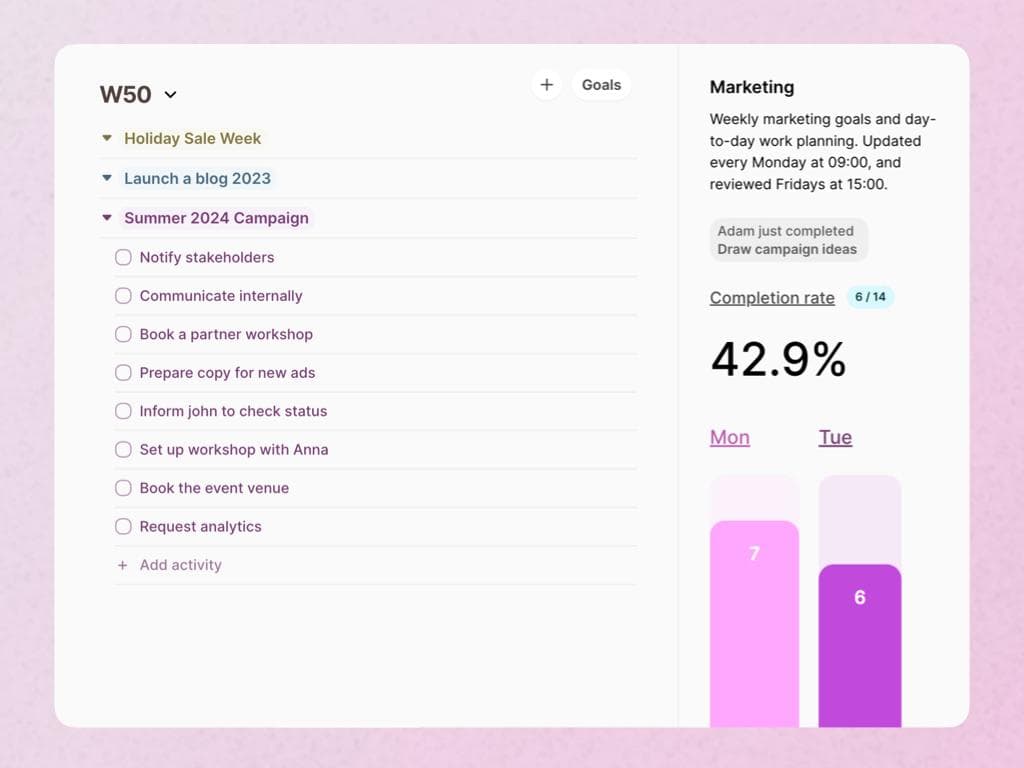The productivity app for you, or your entire team, to get the most important work done with stunningly simple goal planning.
Try it for free ✌️Productivity in the work from home age
The “new normal” era of work is here to stay. By that we of course mean the dramatic shift from a time when most of us worked in physical proximity to our colleagues in one office, to the current distributed and hybrid-remote setup that has now become the norm.
Because regardless of what one might say about remote and distributed work in the pre-pandemic times - a lot of freelancers, for example, worked remotely also 18 months ago - there’s no denying that the current work world in 2021 is very different from the one we were used to in 2019. To put it all in perspective, numbers published by the Economist confirms that prior to the advent of covid, American workers worked from home 5% of their working time, compared to 60% during the pandemic.
But with most of us thus confined to our own kitchen tables, or at best the local coffee shop, what’s happening to the outcome of the efforts we put in? On an individual level, personal preference, work style and - of course - the possible presence of external factors such as children at home, might cause one’s productivity to compare unfavourably to one’s performance in a structured office environment.
On a macro level the picture is clear however. Research confirms that productivity has actually experienced a boost as people began spending less time commuting to and from work and more time working from their home office. Indeed, a recent paper published by academics at Stanford, the Instituto Tecnológico Autónomo de México, University of Chicago Booth School of Business and Hoover Institution predicts that the aggregated productivity in the US is expected to increase by an impressive 5% as a result of the new work arrangements.
Also from a near-term financial perspective employers should welcome the work from home trend, as there are savings of up to USD 11,000 per year to be made from allowing staff to work remotely half of their working time.
With these numbers in mind, it’s perhaps not so strange that more than 50% of companies plan to keep their workforce working remotely in one way or another going forward. However, whilst the productivity boost and cost savings are great news for companies and shareholders, individual workers need to adjust to the long-term consequences of working from home and hybrid-remote work in a thoughtful manner.
Whereas the daily commute previously marked the starting and end to a working day, the boundaries between work and private life are now becoming increasingly blurred. Concerns are raised that the time saved while not travelling back and forth is now instead spent working, thus increasing the working day by some measure. To maintain a healthy work-life balance, employees therefore need to ensure work doesn’t automatically spill over into the private domain simply because their computer now sits at home instead of in the office. Setting a schedule for when work starts and stops, and sticking to it, helps with this. Similarly, employers should ensure that work from home policies cater to employees’ need for down-time.
Ensuring proper boundaries to regulate when work gets done is however only one of the ingredients to remain productive whilst working in a distributed fashion. Another key component is that employers provide the best possible technological infrastructure to enable everyone to produce high quality output. Today, a company’s tech stack is typically a labyrinth of software tools across which individual work-related matters are scattered, including countless solutions for everything from communication, task management, KPI tracking, collaboration to future planning. This means that a significant part of peoples’ typical work day is spent navigating this landscape, which by definition prevents them from focusing on what really matters most: the goals that the organisation works towards, and the activities and processes that lead to the desired results. Companies and decision-makers should therefore actively look to streamline the tech stack and implement better digital support tools in which the functionalities that are required to keep work flowing are available in the same context. This will truly empower employees to keep doing what they are hired for, namely focusing on the things that drive the business forward rather than getting lost in a myriad of disruptive business tools.
If you would like to discuss how you, your team or your entire organisation can create a better digital working environment, I’d love to hear from you (johan@pembio.com)
By: Johan Flodgren

The goal planning app that will skyrocket your productivity
A brand new productivity app - empowering you, or your entire team, to get the most important work done with stunningly simple goal planning.
Get started for free© 2023 Pembio AB. All rights reserved.
Built with lots of love in Sweden. We're deeply passionate
about building the best productivity tool out there.
Org nr: 559274-5375 (SE).
Try the pembio app for free ✌️


